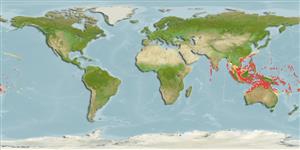分類 / Names
共通名の | 類義語 | Catalog of Fishes(部類, 種) | ITIS | CoL | WoRMS | Cloffa
>
Eupercaria/misc (Various families in series Eupercaria) >
Lutjanidae (Snappers) > Lutjaninae
Etymology: Macolor: Latin, macula, -ae = stain, spot.
More on author: Fowler.
Environment: milieu / climate zone / depth range / distribution range
生態学
海 関連する礁; 深さの範囲 0 - 90 m (Ref. 9821). Tropical; 31°N - 26°S, 72°E - 154°W
Western Pacific: Ryukyu Islands to Australia and Melanesia. Possibly more widespread, but confused in the literature with Macolor niger.
サイズ / 重さ / 年齢
Maturity: Lm ? range ? - ? cm
Max length : 60.0 cm TL オス/雌雄の選別がない; (Ref. 30874)
背面の脊椎 (合計): 10; 背鰭 (合計): 13-14; 肛門の骨 3; 臀鰭: 10. This species is distinguished by the following characters: body relatively deep and laterally compressed, greatest body depth 2.2-2.4 in SL; dorsal profile of head convex in adults, in oblique straight line in young; maxilla without scales or longitudinal ridges; preopercle with a deep notch (or gash) receiving elongate interopercular spine (for individuals of about 20 cm SL); gill rakers of first gill arch 37-42 + 71-81 = 110-122; soft rays of dorsal fin usually 13; continuous dorsal fin with spinous portion distinctly notched in young; dorsal and anal fins distinctly pointed posteriorly, the soft ray of both fins, shorter than next to last ray; caudal fin rounded (individuals < 20 cm SL) and emarginate (individuals >10 cm SL); pelvic fins very long and pointed in young, but short and rounded in adults; soft dorsal and anal fins with scales basally; tubed lateral-line scales 50-55; juveniles with very long pelvic fins. Colour of adults dark grey brown dorsally and shading to yellow on head and ventral body, head with fine blue lines or spots, body scales with blue lines or short dashes, smaller adult with trace or juvenile pattern especially the white spots; juveniles with distinct black and white pattern, with more than 5 white spots on back; subadult similar to juvenile but with white spots on back more numerous and black areas with small white spots (Ref 9821, 90102).
Adults inhabit steep slopes of lagoon, channel, or seaward reefs (Ref. 9710), commonly on deep reef slopes and may be in small groups (Ref. 9710, 48635). Juveniles occur singly on protected reef slopes with feather stars, in staghorn corals or large sponges. Occasionally, they aggregate with M. niger. Apparently feed primarily on large zooplankton at night (Ref. 37816); but also feed largely on fishes and crustaceans. Caught with handlines, gill nets, and traps, also speared by divers. Usually seen in markets and sold mainly fresh (Ref. 9821). Minimum depth reported taken from Ref. 128797.
Life cycle and mating behavior
成熟 | 繁殖 | 放精 | 卵 | 生産力 | 幼生
Allen, G.R., 1985. FAO Species Catalogue. Vol. 6. Snappers of the world. An annotated and illustrated catalogue of lutjanid species known to date. FAO Fish. Synop. 125(6):208 p. Rome: FAO. (Ref. 55)
Human uses
水産業: 商業; ゲームフィッシュ: はい
より多くの情報
共通名の類義語代謝捕食動物生態毒性繁殖成熟放精卵の集合体生産力卵卵の開発
参考文献水産養殖水産養殖の紹介緊張遺伝子のElectrophoreses遺伝病気行列NutrientsMass conversion
用具
特記事項
XMLをダウンロードして下さい
インターネットの情報源
Estimates based on models
Preferred temperature (Ref.
123201): 26.1 - 29, mean 28 °C (based on 946 cells).
Phylogenetic diversity index (Ref.
82804): PD
50 = 0.7500 [Uniqueness, from 0.5 = low to 2.0 = high].
Bayesian length-weight: a=0.01585 (0.00874 - 0.02876), b=2.99 (2.82 - 3.16), in cm total length, based on LWR estimates for this species & (Sub)family-body (Ref.
93245).
栄養段階 (Ref.
69278): 4.0 ±0.65 se; based on food items.
回復力 (Ref.
120179): 手段, 1.4年~4.4年の倍増期間の最小個体群 (Preliminary K or Fecundity.).
Fishing Vulnerability (Ref.
59153): Moderate vulnerability (44 of 100).
Nutrients (Ref.
124155): Calcium = 29.4 [15.1, 53.4] mg/100g; Iron = 0.521 [0.268, 0.946] mg/100g; Protein = 18.5 [16.6, 20.3] %; Omega3 = 0.111 [0.064, 0.187] g/100g; Selenium = 40.3 [21.5, 79.7] μg/100g; VitaminA = 74.2 [20.9, 318.7] μg/100g; Zinc = 0.737 [0.492, 1.105] mg/100g (wet weight);
